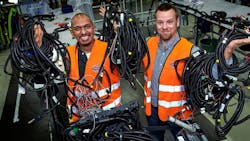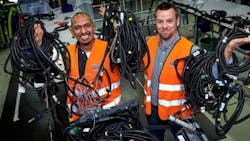From cables to sensors: A wireless approach to truck design
Ask any bodybuilder about upfitting a truck, and they will tell you about the maze of cables that must be navigated. Ask any mechanic about servicing a car or truck with an electrical problem, and they will tell you how sometimes, the answer isn’t so simple.
Which cable is the bad one? Where is the problem located within that cable? Given that a typical truck has between 130 and 229 ft. of cabling, the Volvo Group has gone in search of a solution.
A research project currently underway in Europe is looking at the feasibility of replacing all that truck cabling with wireless sensors. The project is part of DEWI, Dependable Embedded Wireless Infrastructure, which is an EU center for competence and research. DEWI is made up of 58 partners from all over Europe.
“We believe that wireless sensors have a great deal of future potential. One important consideration is that we may no longer need to use large amounts of copper and plastic, which is good for the environment,” says Dhasarathy Parthasarathy, a development engineer at the Volvo Group.
If copper and plastic is replaced, that would represent a reduction of about 20 tons of copper and 36 tons of plastic for Volvo, given 100,000 vehicles produced in a year. It would also eliminate 16 million ft. of cables.
The cables, which carry electricity and data to various components of the truck, would be replaced by wireless sensors to control everything, including the gearbox, lights, switches and the air conditioning system.
The saving also would translate into reduced downtime, something every truck owner wants to hear.
“The savings could amount to a large number of hours, sometimes even days,” says Jonas Hagerskans, a development engineer at the Volvo Group. “In the factory, the cables are awkward to handle and time-consuming to fit in the right place. The wireless sensors are much simpler to install. The cables are also sensitive to dirt and rust and prone to faults. By replacing the cables with wireless sensors, it is possible to prevent all the potential cabling faults. When trucks come into the workshop for repairs, identifying faults in long cables that are difficult to access is very time-consuming. In the future, our customers could get their trucks back from the workshop more quickly.”
The reduction of cables would also make upfitting easier. No longer faced with designing bodies that take into account the placement of cables, upfit engineers may have more freedom to design more efficient truck bodies. The same could possibly be said for the truck designs themselves.
“We really believe in this technology and we will go on developing it. In this project, we have focused on replacing a small part of the large amount of cables in the truck. In the future, we hope to be able to replace more,” says Dhasarathy Parthasarathy.

